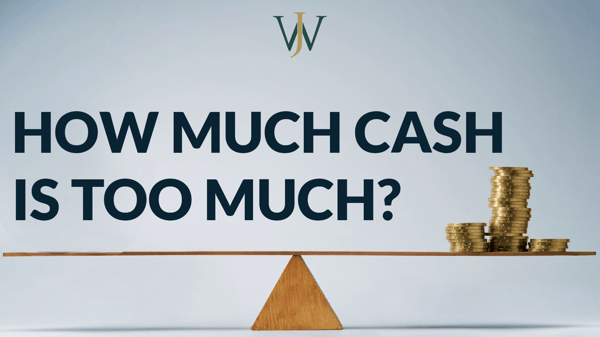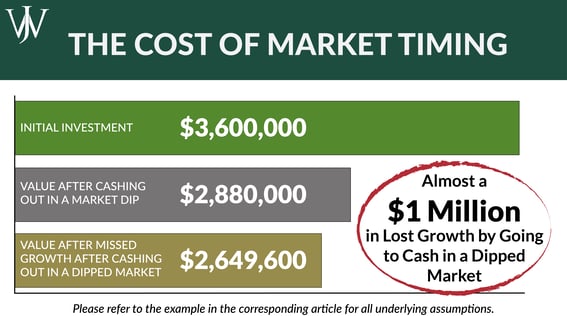You’ve finally made it to retirement. You’ve achieved the goal of financial independence. Now what?
In this article, we talk about making tax-efficient withdrawals in retirement. While smart withdrawals are undeniably crucial and can help optimize your portfolio in your golden years, what should you do about plain, boring cash? A common question we get from clients is: do you need to hold cash, and, if so, how much cash do you need for retirement? We believe a Cash Reserve can be an integral part of your portfolio and strategy post-retirement.
Why? Having an adequate cash reserve offers emergency funds, so you have flexibility over when to sell your investments, peace of mind in times of market volatility, and comfort when spending and enjoying your hard-earned savings in retirement.
How Much Cash Should You Have On-Hand in Retirement?
Let’s talk about the basics: what is a Cash Reserve, and what is its strategy? As the name alludes to, a cash reserve is an account holding only cash or cash-like investments.

The optimal cash-on-hand is likely between one to two years of expenses, depending on an individual’s risk tolerance and annual expenses. It is crucial to identify the right amount to have on hand because your cash reserve number needs to meet the Goldilocks standard: not too much, not too little, but just the right amount.
It’s often pertinent to have enough money set aside to ride out a market downturn or accommodate your needs in a rising-inflation environment.
Benefits of a Cash Reserve
The Cash Reserve concept is important because it offers comfort and security in knowing where your money is coming from.
Peace of Mind
One of the key benefits of having a reserve is peace of mind. If you feel comfortable knowing how you’ll afford your lifestyle if there’s a dip in the market or even a recession, you will be more likely to stick with your investment strategy. Unfortunately, we see many investors without an emergency fund panic while trying to preserve their life savings. These investors get out of the market at the wrong time and make other investment mistakes that do more harm than good.
Security in Your Investment Strategy
On top of sticking to a long-term investment strategy, a cash reserve can also help you do what seems counter-intuitive when the market has fallen: buy. Buying at fire-sale prices and keeping funds invested can substantially augment your portfolio compared to trying to time the market. Too often, we see individuals sell out when the market is crashing and then either never get back in or get back in when the market is at all-time highs again, locking in investment losses.
How Does the Stock Market Impact Your Cash Reserve?
When retirees make tax-efficient withdrawals from their investment accounts during retirement, certain times in the market cycle are more beneficial than others to take these withdrawals.
It’s great to take these withdrawals from your portfolio when the market is up and running, but it’s not always efficient to take them when the market is recessed. Having the right amount of cash set aside for down markets means that you can pay for expenses with the cash reserve to avoid selling invested funds at a bad time.
During good times in the market, sending out systematic distributions regularly to the cash reserve helps act as paycheck replication for retirees. As the market runs, you can elect to pass distributions to a bank account for spending and covering ongoing expenses from your investments. However, during a downturn in the market, you can turn off the systematic distributions from investment accounts and live off of the Cash Reserve until the market recovers. This tax-efficient withdrawal strategy is a great way to supplement the Cash Reserve strategy over time.
How to Replenish Your Cash Reserve in Retirement?
A Cash Reserve can help one ride out a bad market, but we don’t wait until the market dips to think about it. When working with our clients, our goal is to continually top off the Cash Reserve to ensure that their cash flow and liquidity can adapt to any scenario that arises.Generally, once we have decided on the right amount to keep on hand, we will set dividends and interest from a taxable account to be sent out to the Cash Reserve regularly to top off the reserve continually. Additionally, when establishing a cash reserve strategy, we want to use market run-ups to top off the Cash Reserve with distributions from an investment account if the reserves drop below an optimal amount. By leveraging market activity to fund our reserve, we can take profits and lock in gains during good times in the market rather than locking in losses by selling at bad times. Conversely, once we reach our target cash reserve threshold, any cash over and above that amount can be moved into the portfolio to be invested for future growth.
Cash Reserves & Inflation
As mentioned above, we typically believe the right amount to hold in a Cash Reserve is generally one to two years’ worth of expenses. However, that number is unique for each individual’s situation. Often, our focus with clients is ensuring enough is in their reserve for emergencies, but what about having too much set aside? After the December 2021 CPI climbed to 7%, and with banks paying minimal interest on cash, most investors are losing over 6% per year in purchasing power from their on-hand cash! With this in mind, there should be additional focus on finding the right amount to hold, not too much or too little.
Common Mistakes Surrounding Cash Reserves in Retirement
Let’s look at a couple of examples of how a Cash Reserve could have aided retirees, Amy and Matt, in the scenarios below.
After two very successful careers, Amy and Matt reached financial independence at age 60. Together they decided to retire and use their golden years to travel all over the world, a goal they’ve been working toward since they began their careers.
Together, Matt and Amy have the following assets when they retire:
- Matt IRA: $1,500,000
- Amy IRA: $2,000,000
- Joint Taxable Account: $100,000
- Cash in the Bank: $20,000
For the sake of our examples later, we’ll assume a growth on the investment accounts of 8%.
While working, Amy and Matt were very successful savers and had trouble spending for enjoyment, despite having steady incomes. Now that they have no salaries, they find it challenging to travel because of the mental hurdle of spending their hard-earned savings. To finance these trips, they must make withdrawals from their retirement accounts. But, because they live off their retirement accounts, they are considerably more sensitive to market fluctuations because they see market volatility as a threat to a successful retirement.
Falling into the Lure of Stock Market Timing Strategies
Let’s say that Matt wakes up one morning and sees that the market is down 20%. That’s a massive chunk of their retirement savings, just gone!
Matt and Amy decide to go all to cash to protect the rest of their hard-earned savings. Three months later, when the market returns to where it stood initially, Amy and Matt are still afraid to re-invest since they will be purchasing at the top of the market. They will either make one of two decisions:
1) they will keep waiting and waiting for the market to dip again to buy securities at a low price, or
2) they will buy at highs in the market.
Unfortunately, Matt and Amy have fallen into a common mistake by believing they can time the market.
Why Trying to Time the Stock Market Doesn’t Work
Matt and Amy will likely lose out on investment returns if they stay in cash instead of re-investing. However, more importantly, if they weren’t comfortable staying invested during a previous downturn, it’s unlikely Matt and Amy can convince themselves to take advantage of the next dip to get their funds re-invested. Market timing is highly debated amongst financial planners, but we believe it to be a foolish investing strategy for the long-term investor’s benefit. Bank of America looked at data from 1930 to 2020 and found that if an investor missed the S&P 500′s 10 best days each decade, the total return would stand at 28%, but if they held study over the 70 years, the return would have been 17,715%.
We Talk About Market Timing and Other Common Investment Mistakes in Our Webinar, 3 Strategies to Become a Better Investor.
Watch It Now >>
Let’s assume Amy and Matt stay in cash for an entire year after deciding to pull their funds entirely to cash. Then, if the market still hasn’t had a pullback, let’s assume they get back in at the same prices that were available when they were fully invested.
Their investments accounts, initially totaling $3,600,000, became $2,880,000 after Matt and Amy cashed out when the market dipped, a loss of $720,000!
If we also assume a rate of return equaling 8%, Amy and Matt lost an additional $230,400 of growth potential from being out of the market for a year. So by being out of the market for just one year, they took a $950k hit to their retirement portfolio!

Unfortunately, even if Matt and Amy decide to re-invest once the market rebounds (three months later), they will still lock in the $720,000 in losses they took earlier. Both of these decisions have the potential to de-rail their retirement, precisely what they were trying to avoid!
Spending Beyond Your Retirement Budget
Let’s switch up the example to another scenario we often see with people we meet with. What if, instead of being conservative spenders, Amy and Matt have a habit of spending beyond their means and don’t have a good idea of their retirement budget? Between obligations and spending, Matt and Amy need to continue making withdrawals from their accounts even during a downturn in the market.
What if they need $300,000 this year ($25,000 per month) for expenses and the market averages a 25% loss across those 12 months? In this scenario, Matt and Amy face losses of $75,000. While this may not seem like a lot, these losses will add up over time if they continue to make withdrawals during market dips in the future, which can impact their retirement savings and goals.
Cash Reserves can Offer Investment Opportunities
How could these situations have been avoided, and what could Matt and Amy do differently?
If instead, Amy and Matt had additional cash set aside to cover 1-2 years of expenses, rather than only $20,000, they may have felt more comfortable with the dip in the market. While pullbacks are always slightly uncomfortable, a Cash Reserve makes the uncertainty more manageable.
In addition, having an emergency fund set aside allows Amy and Matt the security to sleep at night during the market volatility because they know they have at least two years’ worth of expenses and trip costs set aside to carry them through this downturn. With this peace of mind, they can also see the opportunity this downturn presents to buy on the dips at great prices. Then, as they ride the market back up, Matt and Amy will be in an even better place financially than they were before the dip.
While these fictional scenarios are great, let’s confront a real-life example we all can relate to — March of 2020.
Using Your Emergency Fund During Market Downturns
Cash reserves were the financial heroes for our clients during the COVID recession. When the market dropped in March of 2020, no one knew when it would rebound. The onset of a global pandemic was scary, and the global financial impact was unknown. The cash reserves strategy helped our clients sleep at night during this period of uncertainty, knowing they were prepared for this exact moment.
With each client, we review the Cash Reserve strategy leading up to their retirement. We decide the proper amount of cash to set aside and strategically send systematic distributions into the reserve with dividends and interest when the market is thriving. In addition, we have education sessions on why these reserves are significant and how they can help us make good decisions during market volatility.
In addition to staying invested, we took the market drop as an opportunity to help clients add to their investments by buying asset classes that fell substantially during the drop. Leveraging market momentum through target band rebalancing worked exceptionally well for our clients as they rode the market back up and took advantage of recently-rebounded market areas. Though no one knew how quickly the market would recover, and it recovered more rapidly than expected, the cash reserve strategy allowed us to leverage opportunities in the market by staying invested.
We’ve had excellent market performance following the initial COVID market drop in February 2020, but our job now is to prepare clients for whenever the next market dip occurs, to make sure our reserves are topped off, and to make sure the emergency fund can carry them through the next period of volatility.
A Cash Reserve can be an essential part of your retirement plan. Ask yourself this:
- Will you be ready for the next market drop, and how will you handle it?
- Could having a cash safety net help you be a better long-term investor?
- Could the cash reserves strategy help you budget and rebalance your portfolio regularly?
- Could having cash set aside for expenses encourage you to buy when things are scary in the market?
Efficiently structuring your financials during retirement can allow you to enjoy what you’ve worked so hard for while feeling secure about the market and making withdrawals to enjoy this new chapter in your life.
At Willis Johnson and Associates, we look at the pieces of your financial picture together to ensure nothing gets overlooked. We believe that a cash reserve can be an essential piece of everyone’s financial picture. Together, we can review the optimal amount of cash to hold based on annual expenses in conjunction with your risk tolerance. We have found that those with Cash Reserves have better investment returns over the long run because there is no concern about where funds will come from to cover expenses in a down market. Additionally, the comfort of knowing that cash is available helps decrease reactivity to the market when we see a pullback, allowing funds to stay invested and continue to grow and compound over time.
This strategy can make a substantial difference in your portfolio over time when done correctly. Working with a financial advisor is beneficial to determine if this or other tax-efficient savings strategies can help you reach your long-term goals. Start the conversation with an advisor today.







